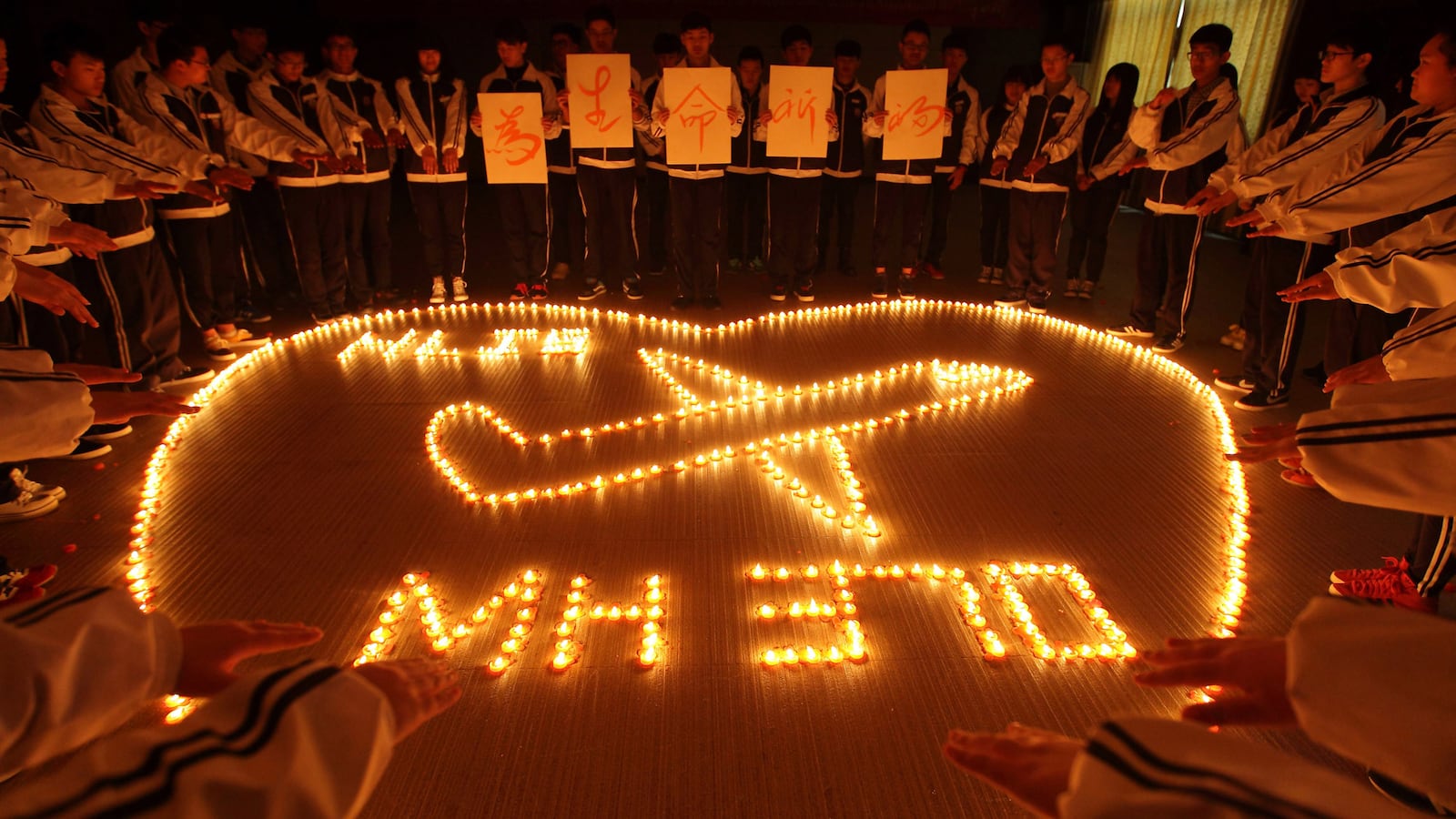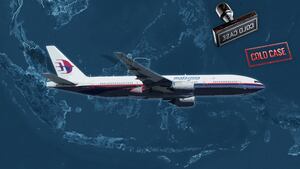The southern hemisphere dawn was breaking. Ahead of the airplane’s cockpit the curving horizon of the Indian Ocean was outlined in crimson, providing a dramatic sense of the planet’s elemental beauty.
The Boeing 777 with 239 souls aboard had been flying for around seven hours and 30 minutes. Like scores of other airplanes across the world at the same moment it was cruising at 35,000 feet at an airspeed of 630mph.
As the two Rolls Royce engines burned through fuel, the 777 became lighter and the computers continually sensed this and adjusted power to maintain height and speed.
The computers exercised an impersonal efficiency. Indeed, the whole flight was an impersonation of a normal flight. No human was apparently engaged in flying it and no jets were supposed to be flying over this remote stretch of the southern Indian Ocean.
Malaysia Airlines Flight MH370 had taken off from Kuala Lumpur at 12:42 a.m. local time on March 8, 2014 and had become a zombie flight. Instead of arriving at its planned destination, Beijing, it had flown thousands of miles in an entirely different direction without any word from the crew.
Now, suddenly, with an initial hiccup, Flight MH370 began to die. One engine, on the right wing, was being starved of fuel and spooled down with a low whine. Fifteen minutes later the left engine also exhausted its fuel and began to falter.
The 777’s nose dropped, pitched up and then began to fall to the ocean in what aerodynamicists call a “fugoid motion,” accelerating swoops of rising velocity. It hit the water at a rate of descent of 2,000 feet a minute—equal to 284 mph and tearing the airplane apart.
In the five years since that catastrophe Flight MH370 has become the greatest unsolved mystery in the history of commercial aviation. An airplane full of people should not be lost without trace in an age where technology should surely ensure that a machine of such size could not simply vanish.
Every year across the world more than 4 billion passengers board a scheduled airline flight with an almost complete certainty that it will arrive safely. Statistically the chance of a fatal crash is one in every 16 million flights.
This level of safety has been achieved by a relentless interrogation of every accident to find the cause. One flaw after another has been identified and eliminated by an international system of investigation.
The underlying doctrine is that no crash should ever remain unexplained. That is why the loss of Flight MH370 remains scandalous; to this day nobody can convincingly explain it. Without locating and recovering the main parts of the 777 there can be no explanation (a score or so pieces of wreckage were found but were not enough to pinpoint a cause).
However, in the five years since the disaster substantial progress has been made in removing a glaring weakness in the oversight of international aviation—the inability to keep a timely and accurate track of airplanes flying over long stretches of ocean.
This potentially dangerous gap first became apparent in 2009 when Air France Flight 447 from Rio de Janerio to Paris disappeared over the south Atlantic with 228 people on board. It was the first disappearance of a large modern jet over water. It took two years to locate the wreck and explain the accident.
French investigators and safety experts warned that the same thing could happen again but were largely ignored—until Flight MH370 proved that they were right.
The responsibility for pressuring the aviation industry to swiftly remedy a problem as serious as this lies at two levels: globally with the International Civil Aviation Organization (ICAO), based in Montreal, charged with establishing basic safety standards; and with each nation’s regulators, who have the legal authority to issue the required rules, of which the largest is the Federal Aviation Administration in America.
Now it seems that advances in technology that offer solutions to safety issues like the warnings raised by the loss of AF447 and reinforced by the case of MH370 are outpacing the ability of large bureaucracies like the ICAO and FAA to codify and embrace them.
This year, for the first time, it will be possible to track in real time every commercial flight whatever its route—including, crucially, stretches of ocean and the polar regions that were not included in the existing surveillance systems.
In January the final part of a network of 66 satellites was placed in orbit that will soon enable complete global coverage for flight tracking.
The satellites are produced and owned by Iridium, a company based in McLean, Virginia. Their network is now being tested and is due to be operational within weeks.
A major mover in this technology is FlightAware, one of the pioneers of making flight data accessible to everyone with an internet connection. They have combined with another McLean-based company, Aireon, to create a service for airlines called GlobalBeacon that enables an airliner to transmit its location, direction, speed and altitude at a rate of at least once every 60 seconds.
Moreover, if the system senses that an airplane is in trouble it sends an automatic alert so that, in the event of a crash into water, the exact location of the crash site could be established within a six-nautical mile radius.
None of this would have been possible without a long-standing international effort to replace a radar-based flight tracking system that dates back to the end of World War II. The replacement is now operational. Inelegantly named Automatic Dependent Surveillance—Broadcast, ADS-B, it transforms the role of both air traffic controllers and pilots. From January 2020 it becomes mandatory in most of the world’s airspace.
With ADS-B the airplane constantly transmits a picture of its position. Pilots see their own position in relation to other airplanes around them and controllers, as well as guiding individual flights, see the larger picture, allowing more efficient management of air space.
With the new fleet of Iridium satellites ADS-B antennas on the airplane transmit data to Aerion receivers on the satellites and from there it moves seamlessly to airlines and controllers.
Flight tracking services like FlightAware also operate terrestrial receivers for tracking flights over land. Flight Aware has become the world’s largest flight tracking company, with links to air traffic control systems in 45 countries and more than 20,000 of its own ADS-B receiving stations in more than 190 countries.
Airlines have welcomed the system because it does not require new avionics in the cockpit, just a software addition. They pay as little as $100 a month per airplane to get real-time position updates of their whole fleets. (Malaysia Airlines was one of the first to sign up.)
The GlobalBeacon system includes an alert that instantly reports if a flight is departing from its planned course, altitude and speed and it already exceeds tracking standards for distress messages set by the ICAO to be in use by 2021.
But it is important to stress what this new system does not do. Notification of a sudden departure from flight path is valuable because it should trigger an early emergency response, but it does not include any data on why this happened.
Critical to this is the information in the flight data recorder (the black box) and the cockpit voice recorder. The ADS-B alert system cannot capture and transmit that data.
All modern jets continually diagnose their vital systems. Data that is vital—it would describe a serious systems failure as a precursor to a crash—goes to the black box. But to be able to relay that amount of data to a satellite in an emergency requires additional avionics equipment—for example, equivalent in its capacity to systems used to provide Wi-Fi and live TV to airplane passengers.
Inmarsat, a London-based satellite operator, is developing a system that provides that increased level of data, but it requires its own expensive new avionics equipment and its own antenna on the airplane. Inmarsat satellites also lack the total global coverage provided by ADS-B through Iridium’s satellites.
Flight MH370’s particular fate raises other issues. For example, ADS-B data is relayed via an airplane’s transponder, a device basic to all airplanes that transmits a constant signal indicating its location.
Until now the range of the transponder was limited by the range of ground radar used to receive the signals – over oceans and out of radar range the transponder could be picked up by other airplanes nearby but not by ground controllers. Aerion’s network eliminates these gaps in oceanic coverage and the transponders communicate constantly from wherever an airplane is to the ground through ADS-B.
However, one of the most challenging questions raised by Flight MH370 is why its transponder stopped working some 40 minutes after takeoff. Whether this had a mechanical cause or resulted from something more sinister remains at the center of the arguments swirling around the mystery of what really happened.
If an airplane loses its transponder in the future it would also lose its ADS-B connection and, therefore, would disappear from the new global tracking system just as Flight MH370 disappeared from the old one.
Although controllers lost contact with the flight, it was hours before an emergency was declared. Ground-based radar had continued to record its flight path until radar contact was lost as the airplane made a final turn into the vast void of the southern Indian Ocean—but nobody had noticed.
In fact, none of the devices aboard the Malaysian 777 that were designed to direct searchers to the location of a crash worked because of the remoteness of the crash site.
The 777 was fitted with four emergency locator transmitters, ELTs, that, on impact with water, were intended to then send signals to a satellite at 50 second intervals indicating the location—it can take as long as 100 minutes for the satellite to establish an accurate fix—but there was no satellite within range to receive those signals.
That left two other devices intended to direct searchers to a wreck, the beacons on the black box and the cockpit voice recorder that send pings to the surface that should be detected by equipment on the searching vessels.
Given MH370’s probable location, that was a hopeless prospect from the start. The pings from the Air France Flight 447 were never detected even though search vessels were within range for a whole month.
The most recent example of how useless this system is comes from the case of Lion Air Flight 610 that crashed into the Java Sea last October. Even though the crash location was found quickly and it was in shallow water, it took seven weeks to find the cockpit voice recorder—essential evidence in this particular crash—and, even then, it was found not by tracing a ping but by divers working at the wreckage site.
The loss of MH370 finally provoked the ICAO to propose a new flight tracking system that they named the Global Aeronautical Distress and Safety System, GADDS.
Airlines were given until November last year to install a tracking system able to transmit position data every 15 minutes and until January 2021 to upgrade that to once-per-minute.
Still unresolved is how to meet the ICAO’s vaguely phrased “timely recovery” goal to locate black box data, either by a device that, in an emergency, streams it to a satellite or by recording it in a more sophisticated version of ELTs that are ejected on impact and float until found. Basic locator ELTs on U.S. military aircraft are ejected on impact and are buoyant.
Each of the two phases of the ICAO’s recommended standards were to be mandated by each nation’s regulators in so-called SARPS, standards and recommended practices. In the case of the first phase, due to begin last year, the FAA has yet to act.
An FAA spokesperson told The Daily Beast: “Tracking is accomplished on the vast majority of commercial aircraft as equipped today. Aircraft tracking does not directly affect the safety of flight, so delaying implementation of a mandate does not impose a risk to the flying public.”
U.S. airlines do not reveal how they track their own fleets, but an industry insider with specialist knowledge of tracking systems told The Daily Beast that the FAA and U.S. airlines were already “largely ahead of the curve with their own long-standing requirements and practices.”
Indeed, the FAA was a prime mover in developing the ADS-B system and, as the systems now being offered by Iridium, Aireon and FlightAware demonstrate, U.S. flight-tracking technology is moving a lot faster than the ICAO’s deadlines—although the industry insider warned me that he thought the 2021 deadline for a solution to the recovery of black box data could slip back as far as 2023. It is unconscionable that it could take a whole decade after the disappearance of MH370 to finally fix a problem that was evident long before this tragedy occurred.










